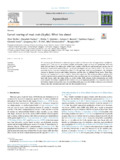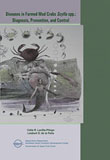Touch-sensitive bristles on the carapace of the mud crab Scylla paramamosain may be receptors for courtship signals
| dc.contributor.author | Kawamura, Gunzo | |
| dc.contributor.author | Bagarinao, Teodora | |
| dc.contributor.author | Loke, Chi Keong | |
| dc.contributor.author | Au, Hsein-Loong | |
| dc.contributor.author | Yong, Annita Seok Kian | |
| dc.contributor.author | Lim, Leong-Seng | |
| dc.date.accessioned | 2020-11-23T04:56:25Z | |
| dc.date.available | 2020-11-23T04:56:25Z | |
| dc.date.issued | 2021 | |
| dc.identifier.citation | Kawamura, G., Bagarinao, T., Loke, C. K., Au, H.-L., Yong, A. S. K., & Lim, L.-S. (2020). Touch-sensitive bristles on the carapace of the mud crab Scylla paramamosain may be receptors for courtship signals. Fisheries Science, 87(1), 65-70. | en |
| dc.identifier.issn | 0919-9268 | |
| dc.identifier.uri | http://hdl.handle.net/10862/6015 | |
| dc.description.abstract | Bristle patches on the carapace behind the eyes were found for the first time in both males and females of the four species of mud crab Scylla spp. Electrocardiography revealed that the bristle patches of Scylla paramamosain were sensitive to touch (with a glass capillary) but not to chemical stimulation (with sugarcane juice). To elucidate the function of these touch signals, the courtship behaviour of S. paramamosain was video-recorded in a broodstock tank. A male approached a female, extended a walking leg over her carapace, touched her bristle patches with a dactyl, mounted her, and probed the bristle patches further with the third maxillipeds. Touch stimulus may be a signal for courtship in Scylla and one of the chain stimuli for the completion of mating behaviour. | en |
| dc.description.sponsorship | This study was partially funded by Universiti Malaysia Sabah grant SDK0028-2018. | en |
| dc.language.iso | en | en |
| dc.publisher | Springer | en |
| dc.subject | Scylla paramamosain | en |
| dc.subject | electrocardiography | en |
| dc.subject | Video observation | en |
| dc.subject | Courtship signal | en |
| dc.subject | crabs | en |
| dc.subject | bristles | en |
| dc.subject | copulation | en |
| dc.subject | Scylla tranquebarica | en |
| dc.subject | Scylla olivacea | en |
| dc.title | Touch-sensitive bristles on the carapace of the mud crab Scylla paramamosain may be receptors for courtship signals | en |
| dc.type | Article | en |
| dc.identifier.doi | 10.1007/s12562-020-01478-2 | |
| dc.citation.volume | 87 | |
| dc.citation.issue | 1 | |
| dc.citation.spage | 65 | |
| dc.citation.epage | 70 | |
| dc.citation.journalTitle | Fisheries Science | en |
| dc.subject.asfa | sexual behaviour | en |
| dc.subject.asfa | receptors | en |
| dc.subject.asfa | carapace | en |
| dc.subject.asfa | marine crustaceans | en |
| dc.subject.asfa | copulation | en |
| dc.subject.asfa | moulting | en |
| dc.identifier.essn | 1444-2906 | |
| local.subject | Electrocardiography | en |
| local.subject | Video observation | en |
| local.subject | Courtship signal | en |
| local.subject | Mating | en |
Files in this item
| Files | Size | Format | View |
|---|---|---|---|
|
There are no files associated with this item. |
|||
This item appears in the following Collection(s)
-
Journal Articles [1258]
These papers were contributed by Department staff to various national and international journals.



